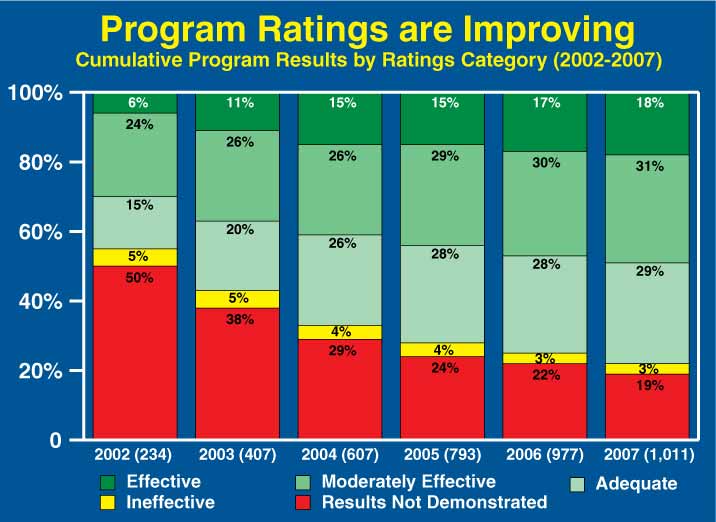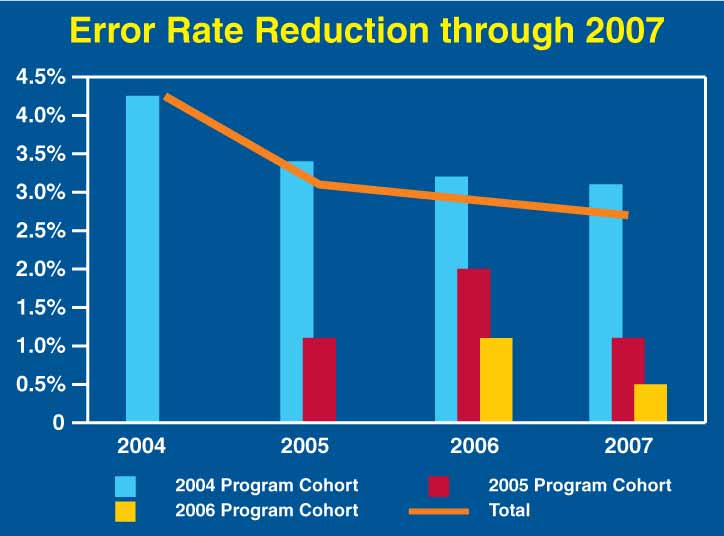
|
|||||||||
MANAGING FOR RESULTS
|
|||||||||
|
Through the President’s Management Agenda (PMA) launched in 2001, Federal agencies and their employees have laid the foundation necessary for continual improvements in Government performance. Agencies, programs, and staff must have clear, transparent goals so that the American people can hold them accountable for results.
The PMA includes five major initiatives. Each initiative’s primary goal is to help make programs work better. These initiatives—Improved Program Performance; Strategic Management of Human Capital; Expanded Electronic Government; Improved Financial Performance; and Competitive Sourcing—have achieved remarkable success. During this Administration, and for the first time, agencies publicly report goals for what they expect to achieve in the next year and beyond.
To institutionalize the results-driven culture of the PMA, President Bush issued an Executive Order (EO) on November 13, 2007, that formalizes the commitment of the Government to spend taxpayers’ money wisely and more effectively every year. The EO ensures agency and program performance is transparent so that taxpayers have the critical information needed to hold Government accountable.
PERFORMING BETTER
Agencies have systematically reviewed the performance of nearly all programs (over 1,000) using a consistent methodology called the Program Assessment Rating Tool (PART). These reviews have helped ensure that all programs have clear, specific definitions of success, outcome-oriented performance measures to track that success, and concrete improvement plans. Importantly, all of this information is transparent and available to the public on www.ExpectMore.gov.
Some key successes:
-
89 percent of programs established or clarified their long-term and annual performance goals to focus on outcomes that are important to the American people.
-
82 percent of programs are achieving their performance goals.
-
73 percent of programs are measuring their efficiency, a relatively new metric for Government programs.
-
70 percent of programs are improving efficiency annually, producing more value per dollar spent.
-
55 percent of programs that were initially unable to demonstrate results have improved their overall performance rating.
Visitors to www.ExpectMore.gov can learn where the Government is successful, where it falls short, and in both situations, what Government is doing to improve program performance every year. They can also find important documents about agency performance and management, including every major agency’s budget, financial report, and performance report card.
|
To improve the results of Federal programs, in 2008 agencies will:
-
Improve the quality of performance and efficiency goals to ensure they are consistent, reasonably aggressive, and outcome-oriented goals.
-
Implement the President’s EO by ensuring each agency appoints a Performance Improvement Officer who is held accountable for coordinating performance management activities and helping the head of the agency hold personnel accountable for results.
IMPROVING HUMAN CAPITAL MANAGEMENT
Federal managers and employees are developing clear goals for each employee that help provide a framework for meaningful feedback on performance. To improve program performance every year, employees must understand how their efforts contribute to agency achievements and work with their managers to devise strategies for continual improvement. Agencies are also working to ensure personnel have the skills they need to achieve their mission and have reduced the time it takes to hire new employees.
Some key successes:
-
81 percent of agencies reduced “skills gaps” in mission critical occupations, up from 77 percent in 2006.
-
77 percent of agencies reduced skills gaps in leadership, up from 58 percent in 2006.
-
78 percent of new employees are hired within a 45-day time frame, up from 64 percent in 2006. The average time to hire is now 31 days, down from 34 in 2006.
To improve the skills and effectiveness of Federal employees, agencies will:
-
Ensure managers are held accountable for outcome-oriented performance goals.
-
Demonstrate that key employee skills gaps have been reduced through a results-based approach by 2008.
For more information, please visit www.results.gov.
USING INFORMATION TECHNOLOGY MORE EFFECTIVELY
By strategically investing in information technology (IT) and professionally managing those investments, agencies are positioned to provide quality information and services to the public. The PMA scorecard has established a framework for effectively using IT to help achieve agency goals.
-
Today, 92 percent of IT systems operate with completed security accreditations, compared to 21 percent in 2001.
-
50 percent of agencies implement IT projects within 90 percent of cost, schedule, and performance expectations.
To expand the benefits received from use of IT, agencies will:
-
Reduce competency and skill gaps in the IT workforce to better achieve program results.
-
Increase citizen satisfaction with IT services.
-
Mitigate security and privacy risks associated with information services.
For more information please visit www.omb.gov/egov.
IMPROVING FINANCIAL AND REAL PROPERTY MANAGEMENT
To ensure managers have current and accurate financial information for decision-making, and that the Federal Government properly accounts for taxpayer resources, agencies have strengthened their financial management practices.
-
For the third straight year, every major Federal agency completed its Performance and Accountability Report within just 45 days after the end of the fiscal year.
-
At the same time, Federal agencies are improving the quality of financial information. The number of clean audit opinions has increased to 19 (of 24), while the number of material weaknesses has declined by more than 35 percent since 2001. In addition, 13 agencies have a clean opinion with no material weaknesses, up from just eight agencies last year. The goals for 2008 are for 21 agencies to earn clean audit opinions and to reduce the number of repeat material weaknesses to 10 percent.
-
Agencies have also continued their efforts to ensure that their mission critical assets are fully utilized and maintained at the right cost and condition. To that end, agencies have identified and disposed of over $7 billion in unneeded property. The goal for 2008 is to dispose of an additional $1 billion in unneeded property and dispose of a cumulative $15 billion by 2015.
For more information please visit www.omb.gov/financial.
ELIMINATING IMPROPER PAYMENTS
Agencies are improving the accuracy of Federal payments by ensuring that dollars are properly accounted for and are going to the right person in the correct amount.
|
Some key successes in 2007:
-
Federal agencies reduced the Government-wide error rate for the programs originally reported in 2004 from 4.25 percent to 3.1 percent.
-
When improper payments were originally reported in 2004, only 30 programs estimated and reported the extent of their erroneous payments. Today, as a result of the Eliminating Improper Payments initiative under the PMA, more than 70 programs have reported this information.
To ensure the accuracy of payments in 2008, agencies will:
-
Continue to monitor and report payment errors.
-
Implement corrective action plans that address root causes of error.
The Federal Government has established an impressive track record of making improper payment measurements transparent to the public and then taking quick and effective action to eliminate them. For more information, please visit www.omb.gov/financial.
USING COMPETITION TO GET TAXPAYERS THE BEST SERVICE AT THE LOWEST COST
Federal managers of commercial activities—such as IT support, accounting, and logistics— continue to use public-private competition to make common-sense decisions about whether taxpayers are better served through performance by a reengineered Government organization or, alternatively, by the best-qualified contractor.
Agencies have projected that competitions completed during the last four years should generate a total of about $7 billion in savings, or an estimated annualized savings of about $1 billion, through process reengineering, workforce realignments, better leveraging of technology, and operational consolidations. Agencies are tracking the implementation of their competitions to ensure results are realized. They already have identified close to $1 billion in actual savings and cost avoidances that enable resources to be focused on better Government services, such as improved stewardship of our national forests and improved disability claims processing.
Agencies will continue to use competitive sourcing where the benefits of public-private competition can help achieve savings and greater Government performance for taxpayers. Agencies have developed plans to independently validate savings and performance improvements and will use these results in evaluating future opportunities for competition.
To achieve even greater savings and better service, in 2008 agencies will:
-
Ensure they conduct independent validations of the results of competitions.
-
Identify future opportunities for competitive sourcing.
-
Work with the Congress to remove legislative restrictions on competitive sourcing. Elimination of these legislative constraints would allow taxpayers to get the best results possible from competitive sourcing and manage their resources in the most effective manner possible.
To further maximize the benefits of competition, agencies across the Government have coordinated their buying strategies to leverage the Government’s vast purchasing power. Strategic sourcing is enabling agencies to reduce contract costs anywhere from 5 to 40 percent, on average, for routine requirements, such as domestic delivery services and office supplies. Through aggressive planning, agencies will ensure the acquisition workforce has the skills to deliver the best results possible and maximize agency effectiveness.
For more information, please visit www.omb.gov/procurement.
USING MANAGEMENT SCORECARDS TO DRIVE RESULTS
While there has been clear progress on each initiative, agencies are committed to continuing to do more in order to make the Government as effective as possible. For example:
-
While about two-thirds of the Budget is allocated to effective or moderately effective programs, the Federal Government continues to spend $138 billion on 222 programs that have not demonstrated results or are ineffective.
-
While about half of the Federal agencies can now quantify and articulate how the benefits derived from their IT investments exceed the costs, half still cannot.
-
While 19 major agencies received clean audit opinions on their financial statements, five did not.
Each initiative has a set of goals that all agencies strive to achieve and these are measured through a public scorecard with red, yellow, and green ratings. An agency earns the top green status when it has successfully achieved all the desired objectives in the initiative. Agencies also receive progress scores that assess how well they are implementing their planned improvements.
With the help of the PMA, agencies have become more disciplined, transparent, and results-oriented in their management of programs, people, costs, and investments. For each management area, agencies identify clear goals and timeframes. They develop plans, identify responsible individuals, and provide resources to achieve these goals.
Each quarter, a scorecard reporting on agencies implementation of each PMA initiative is posted at www.results.gov.
| Federal Register | Jobs at OMB | FOIA | OMB Locator | USA.gov | Accessibility | Privacy Policy | Site Search | Help |


